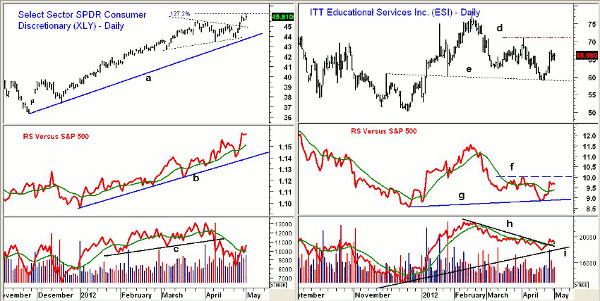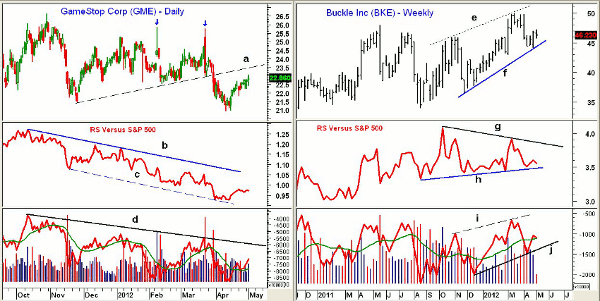High short interest ratios in these consumer discretionary stocks could put short sellers in a very precarious position, especially since not all three look vulnerable from a technical standpoint.
Last week, only one of the Select Sector SPDR ETFs was able to make hew highs for 2012 but also to overcome the highs from 2011. The surprising strength of the Select Sector SPDR - Consumer Discretionary (XLY) caught many by surprise, and last week’s softening in some of the economic data made us question the commitment of the consumer.
In fact, since the April 10 low, the Spyder Trust (SPY) is up 3.6% versus a 5.7% gain in XLY. Despite the media focus on Apple Inc. (AAPL) and Amazon.com (AMZN), the widely watched Select Sector SPDR - Technology (XLK) is up just 1.5%.
There are quite a few stocks in the consumer discretionary sector that have a high short interest. If the sector’s recent upside breakout signals it is now a market-leading sector, then those stocks with high levels of short interest could get squeezed by the market.
Too many put buyers ignore both the short interest data and technical analysis when choosing the stocks they will sell short.
These three consumer discretionary stocks all have short ratios of 15 or higher. This means that it would take at least 15 days of average trading volume in order to cover the short position. Such a high short ratio can increase the risk on put option positions, and one of the three stocks still looks positive technically.
Chart Analysis: The Select Sector SPDR - Consumer Discretionary (XLY) completed its daily flag formation (dashed lines) last week and met its initial Fibonacci flag target Monday at $46.27.
- There are additional upside targets from the flag formation in the $47.20-$47.50 area with the weekly Starc+ band at $47.75
- Daily relative performance, or RS analysis, did confirm the recent highs, as it held well above its uptrend, line b
- Weekly RS analysis (not shown) has also confirmed the price action
- Daily on-balance volume (OBV) has moved back above its weighted moving average (WMA) but has not confirmed the price action, as it is below support (line c) and the late-March highs
- In contrast, the weekly OBV is positive and has confirmed the price action
- There is now initial support for XLY in the $45.20-$45.60 area with further support at $44
- The recent correction in XLY held well above the daily uptrend, line a, which is now at $43.80
ITT Educational Services Inc. (ESI) is a $1.6 billion education services and training company. The stock peaked at $77 in the middle of February and dropped to a low of $58.86 (line e) on April 20. A break of this level would suggest a drop to the $53-$55 area.
- Daily relative performance has moved back above its weighted moving average after testing support at line g
- The RS line needs to move back above the resistance at line f to signal that it is starting to outperform the S&P 500
- Daily OBV has just broken its three-month downtrend, line h, and is back above its weighted moving average
- The OBV has so far held well above the long-term uptrend from the 2010 lows, line i
- First key resistance on the daily chart is at $71, line d, and if that level is overcome, it would be a positive sign
- ESI has a short ratio of 25.1
NEXT: 2 More Short Plays That Are Far from Certain
|pagebreak|GameStop Corp. (GME) is a $3 billion electronic game retailer that traded as high as $28.66 in May 2011, which was still well below the all-time high of $63.77 achieved in late 2007. The two intraday price spikes (see arrows) were likely short covering, and in both instances, GME closed the day lower.
- The daily chart shows that support, line a, was broken in March after company earnings were released
- The recent rebound has just taken GME back towards this former support (now resistance, line a) in the $23.50 area
- There is further resistance in the $24-$24.50 area
- Weekly RS analysis has been in a downtrend since 2011, and the daily chart shows a pattern of lower highs and lower lows in the RS, lines b and c
- Daily OBV is also in a longer-term downtrend, line d, but has recently moved back above its weighted moving average
- There is key support now at $21.60-$22, which, if broken, would be negative
- GME has a short ratio of 16.2
Buckle Inc. (BKE) is a $2.17 billion operator of 422 retail apparel stores whose stock made an all-time high of $49.80 in early-March 2012.
- The weekly chart shows a pattern of higher highs (line e) and higher lows (line f), which is positive
- Near-term support at $44 was tested last week, and further support is at $42.90. A drop below $40 would be more negative
- Weekly RS analysis has not confirmed the recent price action, as it formed lower highs, line g
- As long as the support at line h holds, the RS analysis will stay positive
- Weekly OBV looks more positive, as it formed higher highs in March (line 1) and is back above its weighted moving average. Key support is now at line j
- BKE has a short ratio of 15.1
What It Means: Short interest is something that I generally look at when recommending new long positions, as a high short interest can be an added positive for new longs.
It seems that many put option buyers often have fundamental reasons for believing a stock is moving lower and they do not look at the technical or short interest data. I believe this is a mistake, and those looking to short a stock or buy puts have to look at the short interest data as well as identify key support and resistance levels.
How to Profit: Of these three stocks, GameStop Corp. (GME) looks the most vulnerable, followed by ITT Educational Services Inc. (ESI), especially if it drops below the recent lows.
The weekly analysis of Buckle Inc. (BKE) could top out this month, but it is currently still positive.




















